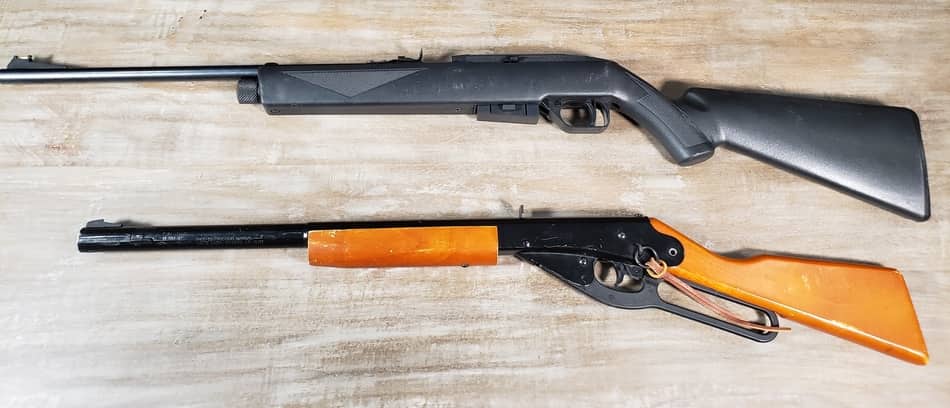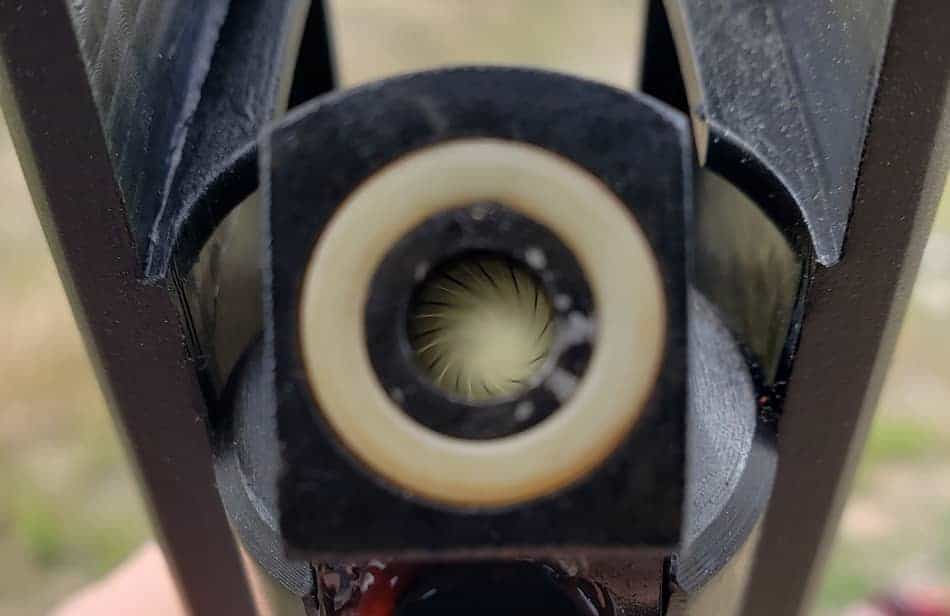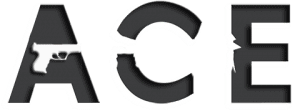
The airgunning world is a great place to be, and for those who want to join we talk about the basics of each type of airgun to help you make an informed choice. So, what is the difference between a BB gun, air rifle and pellet rifle?
BB guns and pellet guns are both types of airguns which shoot a projectile powered by compressed air. The difference between a BB gun and a pellet gun is that a BB gun shoots a round copper BB, and a pellet gun shoots a small lead projectile in the shape of a shuttlecock.
Understanding the differences between these types of guns can help you make the right decision when considering getting an air gun.
Airgun Differences

The primary difference between the two types of airguns is the ammunition used, but how the power is generated and how much of it is generated also plays a role in the differences between the two types of airguns.
Here is a quick list of how power is generated in a BB gun:
- Spring
- CO2
- Hand pump present on the gun
Like I said, a quick list. Here is one for pellet guns:
- Spring
- CO2
- Hand pump present on the the gun
- Compressed air tank
As you can see there is some overlap in how the power is generated, but really the only airguns that will fire both types of ammunition are the multi pump ones. Most of the others are not made with shooting both types in mind.
Pellet Guns: What Do They Do, and How?

Ah, yes! Time to talk about why pellet guns are (in my opinion) way cooler than BB guns.
Because pellet guns use lead pellets which are more dense, easier to work with, and far more aerodynamic than BB guns, they can pack a harder punch over longer distances while maintaining accuracy.
For giggles we decided to shoot a Daisy Buck– a spring powered BB gun– at fifty yards. The first shot only made it half way, and then after adjusting the trajectory of the BB, every shot that hit the target bounced off, while every pellet gun made the target with little difficulty.
This was in part because pellet guns are almost always more powerful than BB guns, more accurate, and pellets are better able to hold onto their energy down range.
Particular higher-end pellet guns are useful for hunting— sometimes even big game hunting. I know, right? Most people probably would not think that pellet guns could be used for that. Fact is, that most of the ones we shot when we were little kids simply could not handle that, but some people use powerful pellet guns to take down boars, deer, and sometimes elk.
Popular pellet guns for these kinds of activities include spring powered guns and precharged pneumatic guns (PCP’s). Suffice it to say for now that these two operate very differently, but accomplish the same thing, though the spring powered one is much less powerful– suitable for small game hunting, but don’t try to take deer with it.
Pellet guns often require a caliber of .177 or .22, which makes them smaller than most normal firearm rounds, though some of those higher-end air guns may be capable of shooting much larger calibers.
This is another way in which pellet guns differ from BB guns, as BB’s come in a standardized size of just smaller than our .177 caliber pellets. So check your pellet size before buying or using in your gun.
Lead pellets also come in wider varieties than BB’s in more ways too. Some pellets have points on them, some have round heads (popular among hunters) others flat heads, and others still being hollow points, with these last two being popular for plinking and pest control. Again, separating themselves from the standardized round ball.
The softer nature of the lead pellets also causes them to distort on impact, which reduces the velocity that the pellet will ricochet at. This causes ricochets from pellet guns to be less dangerous than ricochets from BB guns, but still dangerous. Harder surfaces such as hard rock tend to cause ricochet more than other surfaces.
The distortion caused by the impacts also makes the pellet emit a high-pitched spinning-like sound, so you will know if you do end up ricocheting. BB’s likely won’t make that noise.
These guns also take advantage of a rifling techniques. We’ll discuss this more later in the article, but suffice it to say for now that rifling helps to keep pellet guns more accurate.
Pellet guns:
- Usually use lead pellets shaped like a shuttlecock.
- Come in wider varieties than BB guns
- Are often more powerful than BB guns (but not always).
- Less prone to ricochets.
- Use rifling technology.
- Higher-end pellet guns can be used for hunting
BB Guns: A Common Air Gun
BB guns are a very common air gun, in fact they are probably what most people think of first when thinking about air powered guns; their users often hearing, “You’ll shoot your eye out!”
These guns can come in both pistol form and rifle form, are often used for target practice, and are what many people start shooting with. Higher-powered BB guns can be used for pest control and small game hunting. The small metal balls that they use are often made of steel, and sometimes copper– lighter and much harder than the lead pellets used by their cousins.
These properties of BB guns make their projectiles retain their shape more upon impact, but often don’t penetrate as well as pellet guns. Usually, they are less accurate over greater distances, and more prone to ricochet than pellet guns. BB guns also do not use rifling techniques.
BB guns also require very little maintenance. The soft nature of the lead pellets make it so that as they spin around the barrel, they shed small portions of lead. This doesn’t always cause problems in a pellet gun, but sometimes is the reason that they might lose power and accuracy. The greater durability of BB’s mean that BB guns do not experience this problem.
BB guns:
- Use small steel balls called BB’s.
- Require very little maintenance.
- Often less powerful than pellet guns.
- More prone to ricochets.
How Can I Tell Which One That I Have?

Most of the time, BB guns will be fairly easy to tell apart from a pellet gun for a number of reasons, even though they look very similar, primarily because there should be some kind of writing on the barrel telling you what caliber it is in, including if it is in BB caliber.
Anything other than .177 caliber is a pellet gun, as BB’s only come in .177. Also, keep your eyes peeled for things like magazines, and if so, what kind of magazine they are.
Because the lead is so soft, pellets cannot touch each other in the magazine, as the pressure can distort them, but BB’s can touch each other while under pressure from a spring.BB’s can also be placed into a reservoir in the gun, pellets cannot.
A break barrel springer is a pellet gun, a PCP is a pellet gun, and multi pumps can be BB guns, pellet guns, or both, so keep an eye out for the distinguishing marks like the caliber, writing on the barrel, or reservoirs for BB’s.
Okay, Which Costs More?
Usually, you will be able to find a BB gun for cheaper on the market than you would a pellet gun, with BB pistols (often called air pistols) being the cheapest.
Specific models can buck that trend, but when you begin to look at PCP’s, the price range travels up to the several hundreds of dollars. Spring-powered pellet guns are not as expensive, but will still cost you more than a hand pump gun or one using CO2 cartridges.
Lead pellets also tend to be more expensive. Just as an example, on Amazon.com, the best-selling lead pellets (at the time of this writing) come out to be about two cents per shot.
(at the time of this writing) come out to be about two cents per shot.
The best-selling BB’s on Amazon.com come out to be (at the time of this writing) about to be about one fourteenth the price per shot.
Maybe you will say that I am splitting hairs right now, which may be fair, but if the ammo used in our examples are typical then that means that you will be spending about fourteen times the money to go shooting with the calibers most normally used in airguns.
These numbers likely won’t have much of an impact on your wallet unless you are planning on buying in bulk or plan to shoot a lot over a long period of time.
Which Should I Get?
Air guns can fill different niches, depending upon what you plan to do with them. As we stated earlier, pellet guns tend to be more powerful and accurate over greater distances, making them great for pest control and small game hunting. Consider a pellet rifle if you plan to be doing these activities.
If you plan on just shooting a water bottle around, or having fun trying to get a bull’s eye at a reasonable distance, consider a BB gun. While higher-powered versions are available, making them still viable for hunting or pest control, their low maintenance and usually smaller muzzle velocity combine to make them great for a newer marksman.
Cost may definitely play a factor for many people, and if you would prefer to have a BB gun because of that or other reasons, here  is a well-reviewed air pistol on Amazon.com. If you would prefer to have a pellet gun, here
is a well-reviewed air pistol on Amazon.com. If you would prefer to have a pellet gun, here  is another well reviewed pellet gun.
is another well reviewed pellet gun.
Rifling in Pellet Guns

Rifling, discovered in the late fourteen-hundreds, makes projectiles fired from weapons more accurate over long distances. Previous to then, guns depended upon lead balls in a smooth barrel.
This worked okay for a while, but as the projectile would travel down the barrel, it would bounce around, losing speed and accuracy, making early guns not viable at greater distances.
Rifling fixes this by placing spiraling grooves down the length of the barrel that cause whatever payload you have to spin, gaining stability. This has applications in many different types of ranged weapons, from tanks to pellet rifles.
This technology changed guns forever, and makes your pellet gun much more accurate.
